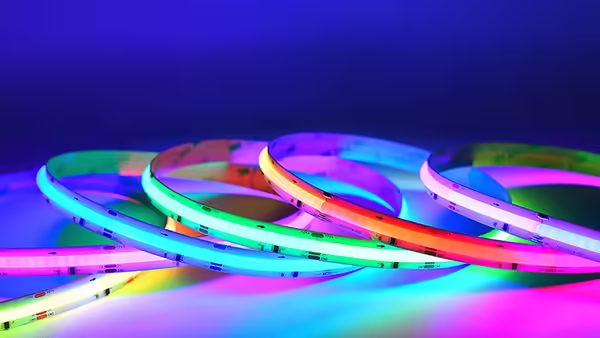
Table of Contents
Introduction to Addressable LED Strips
Addressable LED strips are a game-changer in the lighting industry, offering dynamic lighting capabilities that allow for individual control of each LED. This makes it possible to create intricate lighting patterns and stunning visual effects, making these strips highly versatile for various applications. Whether used for decorative purposes, gaming setups, or architectural projects, addressable LED strips offer unmatched flexibility and creativity.
What is an Addressable LED Strip?
An addressable LED strip is composed of multiple LEDs, each integrated with a control IC (integrated circuit). This configuration enables individual control over each LED’s color and brightness, making it possible to produce complex lighting effects. These strips are commonly used in decorative lighting, gaming setups, architectural lighting, and more. The ability to control each LED separately opens up endless possibilities for customization and animation, making addressable LED strips a popular choice among DIY enthusiasts and professionals alike.

How Do Addressable LED Strips Work?
At the heart of an addressable LED strip is the IC, which receives digital signals and translates them into instructions for the LEDs. These instructions control the color and brightness of each LED individually. Common IC types include WS2812, SK6812, and APA102, each with its specific characteristics and protocols. The ICs communicate through a data line, sending signals in a serial manner to each LED. This allows for precise control and synchronization of the lighting effects.
Types of Addressable LEDs
- WS2812B: Integrated RGB LED and controller IC in one package, offering ease of use and wide availability. It operates on a single data line, making it simple to wire and control.
- SK6812: Similar to WS2812B but with improved color consistency and additional variants like RGBW (white). This type offers better performance in terms of color rendering and is often used in high-end applications.
Applications of Addressable LED Strips
- Home Decor: Enhance the ambiance with customizable lighting to match any mood or occasion. Addressable LED strips can be used to create accent lighting, under-cabinet lighting, and more.
- Gaming and Entertainment: Create immersive environments with reactive lighting that responds to in-game actions and media. This enhances the gaming experience by adding visual feedback and atmosphere.
- Advertising and Displays: Attract attention with dynamic and colorful displays that can be programmed to change. Businesses can use addressable LED strips to create eye-catching signs and promotional displays.
- Architectural Lighting: Highlight structures and spaces with tailored lighting solutions that accentuate architectural features. Addressable LED strips can be used to illuminate building facades, bridges, and public spaces.
Choosing the Right Addressable LED Strip
When selecting an addressable LED strip, consider the following factors:
- IC Type: Different ICs offer varying levels of control and compatibility. Choose one that suits your needs. For example, WS2812B is great for simple projects, while APA102 is better for high-speed applications.
- Uzito wa LED: Higher densities provide smoother effects but may require more power. LED density is measured in LEDs per meter (e.g., 30, 60, 144 LEDs/m). Higher density strips produce more seamless and vibrant lighting.
- Color Options: RGB and RGBW strips offer different color capabilities. RGBW includes a white LED for more color accuracy. RGB strips mix red, green, and blue to create various colors, while RGBW strips add a dedicated white LED for better whites and pastels.
- Power Requirements: Ensure your power supply matches the strip’s voltage and current needs to avoid power issues. Addressable LED strips typically operate at 5V, 12V, or 24V. The power supply should provide sufficient current (measured in amps) for the number of LEDs used.

Installation Tips
- Power Supply: Use a power supply that meets the voltage and current requirements of your LED strip to ensure stable operation. It’s important to calculate the total power consumption of the strip and select a power supply with adequate capacity.
- Data Signal: Ensure a stable data connection to prevent flickering or inconsistent lighting. Use quality connectors and minimize the length of data lines to reduce signal degradation.
- Mounting: Use appropriate mounting solutions to secure the LED strip and manage heat dissipation effectively. Adhesive backing, mounting clips, or aluminum channels can help in proper installation.
- Controller: Choose a compatible controller for your LED strip to achieve the desired lighting effects. Controllers range from simple remote-controlled units to advanced programmable controllers that can be integrated with home automation systems.
Advanced Control Options
- Microcontrollers and Development Boards: Use platforms like Arduino, Raspberry Pi, or ESP8266/ESP32 to program and control addressable LED strips. These platforms allow for complex animations, internet connectivity, and integration with other sensors and devices.
- Software and Apps: Various software tools and mobile apps are available for designing and controlling lighting effects. These tools offer user-friendly interfaces for creating custom animations and managing multiple LED strips.
Troubleshooting Common Issues
- Flickering Lights: Check for stable power and data connections. Flickering can often be caused by loose connections or insufficient power supply. Ensure the power supply is capable of delivering the required current.
- Inconsistent Colors: Ensure the controller is properly configured and compatible with the LED strip. Incorrect settings or mismatched components can lead to color discrepancies.
- Dead LEDs: Inspect for physical damage or faulty connections. Sometimes, a faulty LED can cause issues in the strip. Replacing the faulty section or LED can resolve the problem.
- Signal Degradation: Over long distances, the data signal can degrade, causing unreliable performance. Use signal amplifiers or repeaters to maintain signal integrity.
Transform Your Space with LED Info Studio
Ready to bring your lighting projects to life? At LED Info Studio, we provide high-quality addressable LED strips that cater to your specific needs. Whether you’re enhancing your home decor, creating immersive gaming environments, or designing dynamic advertising displays, our products offer the flexibility and reliability you require.
Contact us now to explore our range of addressable LED strips, controllers, and accessories. Our expert team is here to assist you in selecting the right products and providing guidance on installation and customization. Transform your space with stunning, energy-efficient lighting solutions from LED Info Studio.

